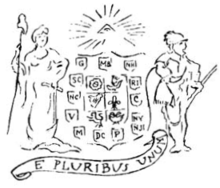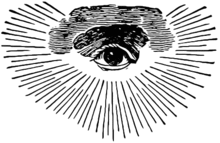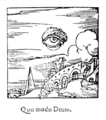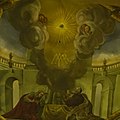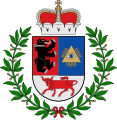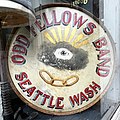
The Great Seal is the seal of the United States. The phrase is used both for the impression device itself, which is kept by the United States secretary of state, and more generally for the impression it produces. The obverse of the Great Seal depicts the national coat of arms of the United States while the reverse features a truncated pyramid topped by an Eye of Providence. The year of the U.S. Declaration of Independence, 1776, is noted in Roman numerals at the base of the pyramid. The seal contains three Latin phrases: E Pluribus Unum, Annuit cœptis, and Novus ordo seclorum.

The caduceus is the staff carried by Hermes in Greek mythology and consequently by Hermes Trismegistus in Greco-Egyptian mythology. The same staff was borne by other heralds like Iris, the messenger of Hera. The short staff is entwined by two serpents, sometimes surmounted by wings. In Roman iconography, it was depicted being carried in the left hand of Mercury, the messenger of the gods.

Charles Thomson was an Irish-born patriot leader in Philadelphia during the American Revolution and the secretary of the Continental Congress (1774–1789) throughout its existence. As secretary, Thomson, a Founding Father of the United States, prepared the Journals of the Continental Congress, and his and John Hancock's names were the only two to appear on the first printing of the United States Declaration of Independence.

A hexagram (Greek) or sexagram (Latin) is a six-pointed geometric star figure with the Schläfli symbol {6/2}, 2{3}, or {{3}}. Since there are no true regular continuous hexagrams, the term is instead used to refer to a compound figure of two equilateral triangles. The intersection is a regular hexagon.

E pluribus unum – Latin for "Out of many, one" – is a traditional motto of the United States, appearing on the Great Seal along with Annuit cœptis and Novus ordo seclorum which appear on the reverse of the Great Seal; its inclusion on the seal was suggested by Pierre Eugene du Simitiere and approved in an act of the Congress of the Confederation in 1782. While its status as national motto was for many years unofficial, E pluribus unum was still considered the de facto motto of the United States from its early history. Eventually, the U.S. Congress passed an act in 1956, adopting "In God We Trust" as the official motto.

Annuit cœptis is one of two mottos on the reverse side of the Great Seal of the United States. The literal translation is "[He] favors [our] undertakings", from Latin annuo, and coeptum. Because of its context as a caption above the Eye of Providence, the standard translations are "Providence favors our undertakings" and "Providence has favored our undertakings".

The Rose Cross is a symbol largely associated with the legendary Christian Rosenkreuz, a Christian Kabbalist and alchemist said to have been the founder of the Rosicrucian Order. The Rose Cross is a cross with a rose at its centre, which is usually red, golden or white. It symbolizes the teachings of a Western esoteric tradition with Christian tenets.

The vesica piscis is a type of lens, a mathematical shape formed by the intersection of two disks with the same radius, intersecting in such a way that the center of each disk lies on the perimeter of the other. In Latin, "vesica piscis" literally means "bladder of a fish", reflecting the shape's resemblance to the conjoined dual air bladders found in most fish. In Italian, the shape's name is mandorla ("almond"). A similar shape in three dimensions is the lemon.
Hundreds of conspiracy theories about Freemasonry have been described since the late 18th century. Usually, these theories fall into three distinct categories: political, religious, and cultural. Many conspiracy theories have connected the Freemasons with worship of the devil; these ideas are based on different interpretations of the doctrines of those organizations.

Humanum genus is a papal encyclical promulgated on 20 April 1884 by Pope Leo XIII.

The double-headed eagle is an iconographic symbol originating in the Bronze Age. A heraldic charge, it is used with the concept of an empire. Most modern uses of the emblem are directly or indirectly associated with its use by the late Byzantine Empire, originally a dynastic emblem of the Palaiologoi. It was adopted during the Late Medieval to Early Modern period in the Holy Roman Empire, Albania and in Orthodox principalities, representing an augmentation of the (single-headed) eagle or Aquila associated with the Roman Empire. In a few places, among them the Holy Roman Empire and Russia, the motif was further augmented to create the less prominent triple-headed eagle.

The Cross and Crown is a Christian symbol used by various Christian denominations. It has also been used in heraldry. The emblem is often interpreted as symbolizing the reward in heaven coming after the trials in this life.
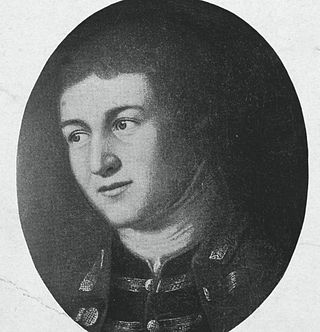
William Barton was a Pennsylvania lawyer, scholar, and the designer of the Great Seal of the United States.

The Square and Compasses is the single most identifiable symbol of Freemasonry. Both the square and compasses are architect's tools and are used in Masonic ritual as emblems to teach symbolic lessons.
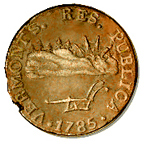
Vermont coppers were copper coins issued by the Vermont Republic. The coins were first struck in 1785 and continued to be minted until Vermont's admission to the United States in 1791 as the State of Vermont.

Masonic ritual is the scripted words and actions that are spoken or performed during the degree work in a Masonic lodge. Masonic symbolism is that which is used to illustrate the principles which Freemasonry espouses. Masonic ritual has appeared in a number of contexts within literature including in "The Man Who Would Be King", by Rudyard Kipling, and War and Peace, by Leo Tolstoy.
The Grand Lodge of British Freemasonry in Germany is a Masonic Grand Lodge in Germany working in the English language and following English Masonic traditions. It was founded as a District Lodge in 1957 and after various transformations was eventually recognised as Grand Lodge in 1980. This Grand Lodge is one of the five United Grand Lodges of Germany (VGLvD). It currently has members from a variety of nations and in addition to the "resident members" in Germany, there are "non-resident members" all over the world. Currently, 19 lodges work under the GL BFG, mainly in North Rhine-Westphalia, but also in Lower Saxony, Hamburg, Munich, Berlin and also near Frankfurt.
"Heavy Metal Poisoning" is a song by American rock band Styx. It was included as the fifth track on their 1983 studio album Kilroy Was Here.
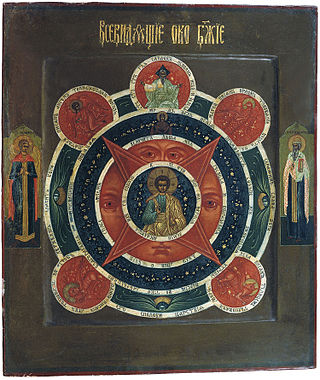
The Eye of Providence or the All-Seeing Eye of God is a type of Orthodox icon that emerged in Russian iconography in the 19th century. The image of the Eye of Providence, inscribed in a triangle, appeared in the paintings of Russian Orthodox churches from the end of 18th century to the first half of 19th century, later in the Russian iconography, mostly notably among the Old Believers. It is a symbolic and allegorical composition of the words from the Holy Scripture that represents the omniscient and vigilant all-seeing eye of Christ.
This article provides a list of notable depictions of the Great Seal of the United States, excluding the official dies.

